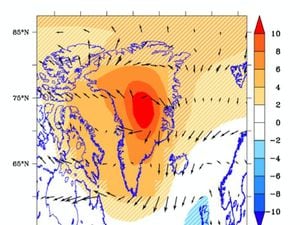Climate models ‘underestimating Greenland’s future ice melt’
Unusually clear skies may have led to a record loss of Greenland ice in 2019, researchers say.

Climate models may be vastly underestimating how much ice will melt in Greenland in the future, a group of scientists believe.
Their analysis is based on the record loss of Greenland ice in 2019, which researchers believe was caused not just by warm temperatures but also unusual atmospheric conditions that led to clear skies in the summer.
According to Dr Marco Tedesco, from Columbia University’s Lamont-Doherty Earth Observatory, current global climate models are not able to capture the effects of a “wavier jet stream” – a phenomenon that can lead to extreme weather conditions.
As a result, he believes simulations of future impacts are significantly underestimating the mass loss due to climate change, adding: “It’s almost like missing half of the melting.”
The Greenland ice sheet contains enough frozen water to raise sea levels by as much as 23 feet (7m).
Understanding the impacts of atmospheric circulation changes will be crucial for improving projections for how much of that water will flood the oceans in the future, Dr Tedesco said.
A team of researchers used satellite data, ground measurements, and climate models to analyse changes in Greenland’s ice sheet during the summer of 2019.
They found last year was one of the worst years on record, which saw the Greenland ice sheet’s surface mass balance drop by about 320 billion tons, below the 375-billion-ton average for 1981-2010.
Before that, 2012 was considered to be the worst year for surface mass balance, with a loss of 310bn tons.
The team found the ice loss in 2019 was linked to high-pressure conditions – called anticyclonic conditions – that prevailed over Greenland for long periods of time.
These conditions prevented the formation of clouds in the southern portion of Greenland, letting in more sunlight to melt the surface of the ice sheet.

According to the researchers, this resulted in about 50 billion fewer tons of snowfall than usual being added to the mass of the ice sheet in 2019.
Conditions were different but no better in the northern and western parts of Greenland, the team added, due to the high pressure system spinning clockwise and pulling warm, moist air into the region and creating a small-scale greenhouse effect.
The researchers believe these conditions will become more common in Greenland.
Dr Tedesco said: “These atmospheric conditions are becoming more and more frequent over the past few decades.
“It is very likely that this is due to the waviness to the jet stream, which we think is related to, among other things, the disappearance of snow cover in Siberia, the disappearance of sea ice, and the difference in the rate at which temperature is increasing in the Arctic versus the mid-latitudes.”
The research is published in the journal The Cryosphere.





